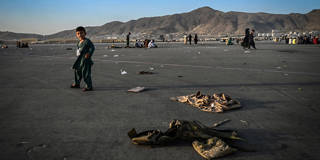BRAHMA CHELLANEY

NEW DELHI – In the year since the United States’ disgraceful abandonment of Afghanistan to the Taliban, the country has gone down precisely the path any logical observer would have predicted: a medieval, jihadist, terrorist-sheltering emirate has been established. The US will incur costs for betraying its Afghan allies for a long time to come. But nobody will pay a higher price than Afghans.
The geopolitical fallout of America’s humiliating retreat from Afghanistan – after President Joe Biden followed through on the withdrawal commitment of his predecessor, Donald Trump – is still growing. By exposing the US as a power in decline, the withdrawal gave a huge boost to militant Islamists everywhere, while emboldening Russia and China. It is no coincidence that, not long after the fall of Kabul, Russia began massing forces along Ukraine’s borders, and China sent a record number of warplanes into Taiwan’s self-declared air defense identification zone.
But things are much worse in Afghanistan. Women and girls have lost their rights to employment and education, with many girls subjected to sexual slavery through forced marriages to Taliban fighters. Taliban death squads have been systematically identifying and murdering those who cooperated with US forces. Torture and execution have become commonplace. Afghanistan’s Hindus and Sikhs – descendants of those who withstood the medieval-era conversions to Sunni Islam by the country’s Arab conquerors – have been fleeing to India to avoid slaughter.
The regime’s cabinet is a veritable who’s who of international terrorists and narcotics kingpins. Sirajuddin Haqqani, who is responsible for Afghanistan’s internal security and preventing the country from becoming a safe haven for international terrorists, is the leader of the ruthless Haqqani network. The US has designated him a “global terrorist” and placed a $10 million bounty on his head.
Not surprisingly, the Taliban continues to shelter known terrorists, as the recent Biden-ordered assassination of al-Qaeda leader Ayman al-Zawahiri in central Kabul showed. While Biden was quick to take a victory lap after al-Zawahiri’s killing, the assassination hardly reflects well on him. A year ago, when ordering US troops to beat a hasty retreat, he claimed that the US no longer had any interest in Afghanistan, because al-Qaeda was already “gone.” (No matter that, just weeks earlier, a United Nations Security Council report had shown that al-Qaeda militants were fighting alongside their Taliban associates.)
Compounding the danger to Afghanistan and its neighbors, the US left behind $7.1 billion worth of weapons in its chaotic withdrawal from the country. According to a recent Pentagon report, the US has no plans to retrieve or destroy the equipment, despite recognizing that the Taliban has already “repaired some damaged Afghan Air Force aircraft and made incremental gains in its capability to employ these aircraft in operations.”
In short, Biden’s decision to overrule his generals and withdraw from Afghanistan – a month before his own target date of September 11 – has created a security and humanitarian nightmare. And Biden is nowhere near finished making foreign-policy blunders in Afghanistan.
After Kabul’s fall, US Secretary of State Antony Blinken declared that the US would judge its future engagement with the Taliban-led government based on “one simple proposition”: whether it helps the US advance its interests, including “seeing that women’s rights are upheld,” delivering humanitarian assistance, and pursuing counterterrorism. But even though the Taliban has failed on all three counts, the Biden administration is gradually easing sanctions on the regime.
At the UN, the US spearheaded a resolution providing for a humanitarian exemption to the sanctions imposed on Afghanistan. The US Treasury Department’s General Licenses, aimed at facilitating the provision of humanitarian relief, now allow financial transactions involving the Taliban and the Haqqani network. And the US is currently negotiating with the Taliban over the release of $3.5 billion of Afghan central-bank reserves.
Meanwhile, the US refuses to target Haqqani or other leading terrorists in Kabul. Yes, al-Zawahiri was assassinated, but, contrary to the Biden administration’s narrative, he was not all that influential. He was largely retired, living with members of his extended family in a Kabul house under Haqqani’s protection.
What’s next? Will the US now reward Pakistan – one of America’s 18 “major non-NATO allies” – for opening its airspace to the drone that killed al-Zawahiri? True, Pakistan reared the Taliban and engineered the US defeat in Afghanistan, but now it wants an early International Monetary Fund loan dispersal to help it avert a debt default.
Likewise, will the US now continue to pursue the release of Afghanistan’s central-bank reserves to the Taliban, despite its indisputable harboring of terrorists and establishment of an oppressive and violent Islamic state? The Biden administration defends its engagement with the Taliban by speciously contending that the top terrorist threat in Afghanistan is the Islamic State-Khorasan. But ISIS-K has relatively few members, no state sponsor or Afghan allies, and controls no territory.
The Biden administration seems committed to striking a kind of Faustian bargain with the Taliban. But to what end? The Taliban’s political power and Islamist ideology make it a critical link in the international jihadist movement. And its rule is threatening to turn Afghanistan into a breeding ground for international terrorism, narcotics trafficking, and mass migration. There is no justification for engaging with it.
Through its precipitous and bungling withdrawal from Afghanistan, the Biden administration handed Islamists worldwide their greatest victory. But the war in Afghanistan is hardly over. As the Taliban’s self-styled emir, Mullah Haibatullah Akhundzada, recently declared, “This war never ends, and it will continue till judgment day.”
No comments:
Post a Comment